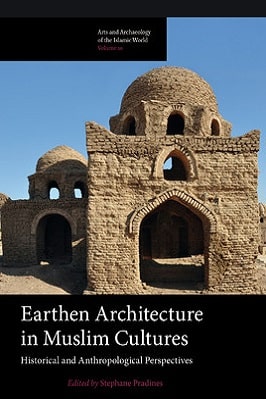
| Earthen Architecture In Muslim Cultures |
| Stéphane Pradines |
| 294 |
| |
| PDF Direct Download Link |
| Click for Hard Copy from Amazon |
Earthen Architecture in Muslim Cultures
Historical and Anthropological Perspectives Edited by Stephane Pradines
EARTHEN ARCHITECTURE IN MUSLIM CULTURES
Contents
- Acknowledgements and Note on Transliteration ix
- Notes on Contributors x
- Introduction: An Architecture for the Caliph and the Poor 1 – Stéphane Pradines
- Adobe as an Islamic Standard: Vernacular Cosmopolitics 11 – Rolando Melo da Rosa
- The Great Mosque of Timbuktu: Seven Centuries of Earthen Architecture 22 – Bertrand Poissonnier
- The Periphery Walls of Sijilmāsa, a Medieval Islamic City in Morocco: Contribution to the Identification of Typological and Functional Variability of the Pisé Technique 37 – François-Xavier Fauvelle, Elarbi Erbati, Romain Mensan and Axel Daussy Draa Valley: Tighremt and Igherm, Morocco 55 – Marinella Arena and Paola Raffa
- The Use of Earth in the Construction of the Qṣūr in Southeastern Algeria 84 Mounia Chekhab-Abudaya
- Identity and Architecture: The Fātimid Walls in Cairo 104 Stéphane Pradines
- Mud Brick Architecture in Ḥaḍramawt-Yemen under the Quʿaiti and Kathiri Sultanates 146 Christian Darles
- Building on the Shoreline: Insights into the Use of Earth in the Architecture of the Late 18th and 19th Centuries in Qatar 167 Moritz Kinzel
- Residential Compounds: Earthen Architecture in the Central Desert of Iran 203 Atri Hatef Naiemi
- Traditions of Monumental Decoration in the Earthen Architecture of Early Islamic Central Asia 233 Paul D. Wordsworth
- Ottoman Earth Architecture in Buda (1541–1686) 249 Adrienn Papp
Qurʾan Revelation and Ḥadīth Credibility
Despite all the questions about the revelation and inspiration of the Qurʾan, “the permanent and perplexing binomial of Muslim philosophy, of the pure intellect—that answers to the immanent Qurʾan and of the divine intellect, that answers to the Logos” rests on the “Uncreated Qurʾan, from which derives, by revelation, the earthly Qurʾan”.1
Thus, the contrary assumption that is possible to construct the Qurʾan is at odds with the eternal credit of its uncreated matrix and with its revelation learnt by heart,2 as plainly stated by its own definition as a glorious recitation inscribed in a Preserved Tablet (Q 85:21-2), an archetypi- cally celestial matrix—the Mother of the Book (Q 13:39)—that was written in Heaven by the An- gels (Q 68:1-4).3
According to Hans Küng, however, “Muslims of the twenty-first century need not maintain the uncreatedness and therefore the perfection, in- fallibility and immutability of the seventy-eight thousand words of the Qurʾan (and, indirectly, the words of the Sunnah of the Prophet and the Shariah)”.4
The number of Muslims and non-Muslim spe- cialists in Muslim studies that can agree with Küng may not be negligible, but if it is consen- sual that Ḥadīth can and should be disputed in terms of credibility, the matter of Qurʾan is alto- gether different.
The dividing lines between the revelation—historically unveiled and narrated through the Qurʾan—and “what is regarded as Islamic law nowadays” result from the hybridiza- tion of references, building on centuries of juristic opinions.5
Ḥadīth can be emphasized to serve an anti- traditional orientation, a manifest peril since the outset of Islam, being the fabrication of reports to support this or that ruler or political leadership an age-old practice:
“Ḥadīth reports (‘Tradition’) form only a part of the actual Islamic tradition; that a stress on such reports may or may not indicate what is ordinar- ily called traditionalism in a man; that, in fact, a strict ḥadīth-mindedness, now as ever, may well imply an anti-traditional orientation in several respects.”6
To take into account what we are debating, is of the essence. Each ḥadīth must be tested for cred- ibility, i.e., for the strength of its connectivity in relation to Qurʾanic and Prophetic standards.
Striving to religiously7 assess earthen architecture in Islamic terms, with an approach based on actor- network theory, one must test its eventual direct connection to Qurʾanic and Prophetic standards, while following its actors and them back, tracking down its trajectories.8
To read more about the Earthen Architecture In Muslim Cultures book Click the download button below to get it for free
or
Report broken link
Support this Website
for websites